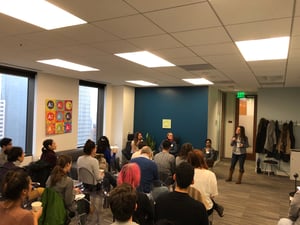 We all know about speed dating, where eligible singles come to meet and chat with a number of new potential partners for short stretches of time. But now, we’re seeing this format gain popularity among product teams too. Last week, we hosted a panel with experts from Gap Inc. and Dropbox to learn more about how speed dating is being used for user research. They shared their insights on the different ways they’ve implemented the methodology and the challenges and considerations that go along with it.
We all know about speed dating, where eligible singles come to meet and chat with a number of new potential partners for short stretches of time. But now, we’re seeing this format gain popularity among product teams too. Last week, we hosted a panel with experts from Gap Inc. and Dropbox to learn more about how speed dating is being used for user research. They shared their insights on the different ways they’ve implemented the methodology and the challenges and considerations that go along with it.
While UX speed dating can take many forms, at its core it's a methodology that uses quick, lightweight sessions to get fast feedback on multiple concepts during the product development lifecycle, not just at the end. During the concept and ideation phase of product design, we often dream up hundreds of concepts, but it’s difficult to validate those concepts with real users in any tangible way. Speed dating lets you accomplish early stage concept validation by testing a variety of concepts, pieces, or designs, and ultimately, better prioritize user needs.
How can you use speed dating?
Let’s say you have 6 concepts you’d like to test, but none require a full-length interview. With speed dating, you can bring in 6 people to be matched up with 6 different designers, moving around the room every 10 minutes to give feedback on each idea. As a methodology, speed dating is very malleable. There are many ways to adapt it to meet your needs. You might do 5-minute rounds, or if you have something more substantial, 15-minute sessions. But ultimately, it accomplishes multiple interviews in a shorter amount of time and allows more than just researchers to get involved in the process.
"It’s a helpful tool to help us get more than just researchers involved in the research process. [We’re] democratizing research for the larger team."
- Aruna Balakrishnan, Design Research Lead, Dropbox
If your research team can’t keep up with research requests or is doing too much tactical work while pushing your formative research to the back burner, this is a great technique to empower your designers to conduct their own research. For a relatively low time commitment, designers can build empathy for their users and get fast feedback to help them validate and improve their designs during product development. By opening up the research process, you’re freeing up time for your researchers to do more formative work and clearing the backlog of research requests.
"For us, it's all about building empathy for the customer. That is our number one job. [...] That was sort of the impetus behind giving our designers the experience of actually talking to customers; not being behind a wall or listening to a video later, but getting them well versed in how to talk to a customer."
- Jennifer Symes, Director, Consumer Insights, Gap Inc.
It’s important to note that speed dating has limitations. If you’re doing a large redesign of a product, or need to do formative in-depth research for your company, speed dating alone may not be the best approach. But, when you’re considering small changes like a product description or button placement, this is where speed dating thrives.
Make sure you address these challenges and considerations
While speed dating is meant to be fairly easy to pull together, there are a few considerations you should be thinking about when putting this into practice.
 Empower your designers think like researchers.
Empower your designers think like researchers.
As a researcher, you’re aware of how you set up a study to the reporting best practices. You’re experienced in talking to customers in a non-leading way. But for designers who may be doing this for the first time, it’s important to help them understand these nuances and the research process overall. Organize a group meeting before the research sessions to share best practices on how to ask questions, the most effective methods for note-taking, and how to analyze their results in a constructive way.
 Screen your participants carefully.
Screen your participants carefully.
Remember, with speed dating, you’re testing several different experiences or concepts with the same set of users, so if two experiences call for drastically different user groups, you may have a problem. For each concept you’re testing, you must have the same screening criteria, so ensure you’re coordinating who’s coming in, what you’re testing, and what the goals are.
 Be scrappy, not messy.
Be scrappy, not messy.
Speed dating is meant to be scrappy and a low commitment for your team, but make sure to balance this with having respect for your users. You can’t show up last minute, cancel day-of, or take this any less seriously than another more substantial program of research. Set expectations amongst your team, and strike the balance of making it feel low pressure while being respectful of the people coming into your office.
 Test it out with your teammates!
Test it out with your teammates!
If you’re just getting started, set up a speed dating experience in your office and let your colleagues try it out. Use this information and feedback very casually, as it’s really just to test the methodology, not the design. But, this trial is a great way to see how you’ll use it in context with users.
 Don’t change your strategy over one user.
Don’t change your strategy over one user.
You’re not trying to make major business decisions using speed dating. So, don’t try to understand a whole population or take comments too seriously. Speed dating is meant to help you have quick conversations and guide your process, but don’t make a change based on one comment or even one person. Use it properly!
Do you find practical UX research advice helpful? We regularly host events exploring research approaches like this one. If you’d like to be the first to hear about upcoming events, sign up for our mailing list.